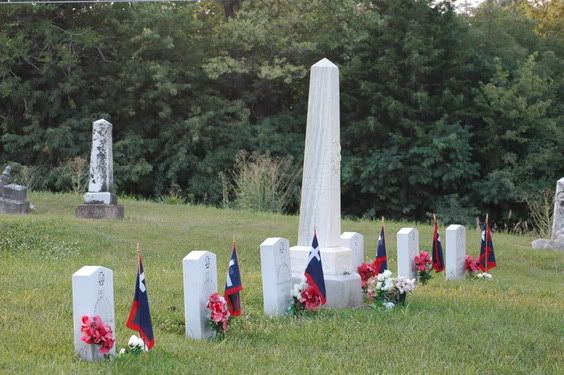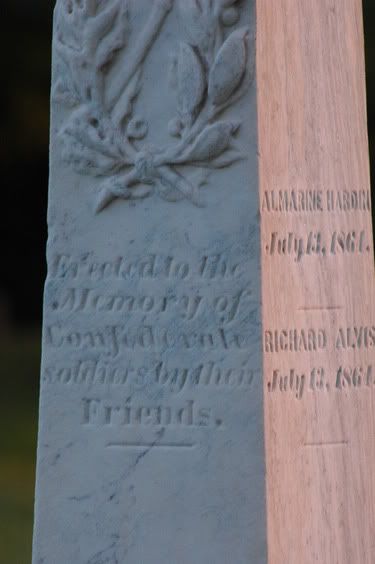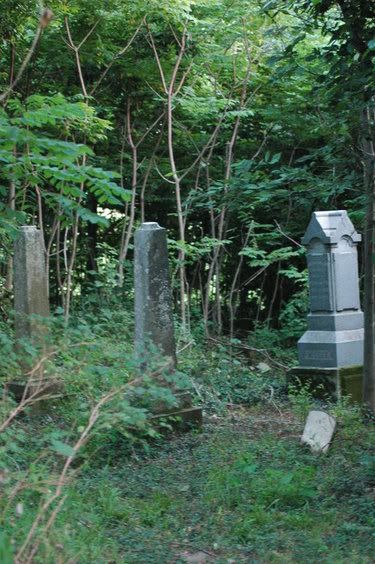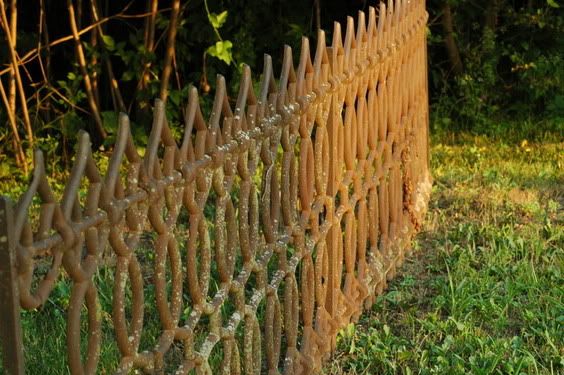This weekend I visited a historically significant Confederate cemetery which is located less than a half mile from my family's farm in northwest Missouri, on the outskirts of Camden Point.
Today's population of Camden Point is 484, up from the 393 I recall it being during my childhood. There are 182 homes in the little town, a branch of the Mid-Continent Library System, a garage, Post Office and the Christian Church. Not much else, except bountiful farming.
Many decades ago there was a Christian College and a military academy. The college was burned at least twice, caught up in the Missouri-Kansas border wars.
Ah, but this adventure... let's get back on course, shall we?
This was the first time I've visited the Confederate Cemetery, simply because it was on the south side of the EE Highway, which is the route we always take to work our way back to Interstate 29. EE has always been an artificial border and I simply hadn't broken through it until Saturday evening.
I'm glad I finally did. I've learned this is the oldest Confederate monument west of the Mississippi River. It was established in 1871, seven years after the death of several members of Thornton's Missouri Cavalry on July 13, 1864.
Here's what I've learned:
In July of 1864, Col. John Calhoun Thornton began recruiting men for Confederate service in Platte County. Even though the puppet Union government of Missouri forced the enlistment of its citizens into the "Enrolled Missouri Militia" (E.M.M.), approximately 1,500 E.M.M. members rallied to the Confederate cause.
These pro-Southern E.M.M. were sometimes known as the "Paw Paw Militia". According to one Federal report, "There never were more than 200 true Union men in this county" and "the Southern sympathizers all call themselves conservative Union men now, and are very active in withholding the facts and misleading the authorities."
Union General Clinton B. Fisk on July 12, 1864, reporting to Maj. Gen. Rosecrans, declared, "the Paw Paw militia in Platte County, with scarcely an exception, went over to Thornton in a body, and the great mass of the citizens have thrown off the mask and declared openly for Jeff. Davis and the Southern Confederacy. An abundance of Confederate uniforms was found to be in waiting at Platte City, and the Paw Paws with alacrity exchanged their blue jackets for gray ones.
Major Clark reports the uprising among the people as general... General, be not deceived, Missouri is as rebellious to-day as ever, and the earlier the national authorities act upon this conclusion the better. It will require more than 5,000 reliable U.S. troops to hold my district from a general uprising; every hour I spend among the people confirms me in this opinion."
While an account by Confederate Col. Thornton is not known to survive, it is believed his intentions were to liberate Platte and adjacent counties from Federal occupation and perhaps hold the area long enough until Gen. Sterling Price could arrive with reinforcements from Arkansas.
With a three- to four-hundred-man detachment, Col. Thornton "attacked and captured Platte City and its garrison of militia." Union General Clinton B. Frisk reported, "The Confederate flag has been waving over Platte City for two days, protected by men who for many months have worn our uniforms and carried under the stars and stripes the guns they now turn against us."
In response, Federal forces were not idle. On July 13, 1864, detachments of the 2nd Colorado Cavalry (under Col. J.H. Ford) and the 15th Kansas (under Col. Charles Jennison), sometimes known as "the worst body of cut-throats and freebooters that ever tortured a victim or looted a community", made a surprise attack on approximately 200-300 of Col. Thornton's Confederates at Camden Point.
Union Assistant Adjutant-General, G. A. Holloway reported, "Our combined forces had a fight with the rascals last night at Camden Point, burned the town and mustered out a few devils, but the rest were routed."
Col. J. H. Ford (2nd Colorado Cavalry) reported, "we ran on to the enemy at this place, killing 15 of them. Our loss, 1 killed and 1 badly wounded", "killed no citizens, although many of them need killing" as well as "capturing and destroying a large number of muskets, shotguns, cartridges, accouterments and also ten kegs of powder."
Even though the Federals reported killing 15 of Thornton's men, the Confederate memorial at Camden Point only lists six Confederates who died at the skirmish. The names of these six are: Robert McCormack; Jasper Clements; Almarine Hardin; Richard Alvis; Andrew Smith; and Jesse Myles.
These men were first buried on the battlefield, then later moved to the Camden Point Cemetery nearby. Aside from the human casualities, the loss in arms and especially gunpowder was a devastating loss to Col. Thornton's command. Although Thornton's forces again clashed with federals on July 17th near Fredericksburg (Ray County, Missouri), most of his forces dispersed, and the general uprising abandoned, being replaced with guerrilla tactical warfare.
(I believe this information was provided by Jerry Wheeler on a Camden Point history site. There is no credit given for the writing, but Wheeler is noted as the photographer at Camden Point Confederate Memorial
These are my photos of the cemetery from Saturday evening. The Confederate graves and memorial are on the north end of the cemetery, which also includes many other graves, as you will see.


Local members of the Sons of the Confederacy continue to decorate the graves with Confederate flags, renewed during national holidays. The cemetery was reclaimed from an overgrowth of trees and brush several years ago by civic volunteers and the Boy Scouts.

Nature continues to wage its battle against time, and it is very difficult to maintain the cemetery, especially as lines of families die out in the area. These graves remain hidden in the undergrowth as caretakers continue trying to recover them. The lure to this spot was intense; there was a cottontail rabbit that would hop past me, then stop long enough for me to catch up with him before hopping further into the woods. However, I stopped when I reached this spot, daring not to disturb the spirits long left sleeping here.

Some of the graves in this old cemetery are those of people who were born in the 1700s. I don't know when this family monument was erected, but is obviously has not been standing here as long as many of the headstones.

Many of the monuments have fallen over because of the creep of the ground. The cemetery, which is built on a hill, has fought the movement of the ground in several directions. Restorers have attempted to put all the pieces of these monuments together, with the hope of someday repairing them.

So many of the markers may be lost forever, unfortunately, covered over by the earth. Some of the taller markers were hollow inside when they were made, and so when time tipped them, they crushed under their own weight. I think this progression serves to remind us that from dust we were made and to dust we return, whatever our efforts at immortality may be.

Even in this gated portion of the cemetery, there is little to tell us who lies below the soil. There are iron rods standing in some spots, apparently supports for some of the taller memorials left for loved ones. I am not sure what the fence designated, whether it was a particular family's plot within the cemetery or an area designated for a certain group of citizens.

9 comments:
Trixie, If you like history you should visit this area sometime. It literally stinks with history. Just a few miles from my front door is Fort Frederick, a fort that was used during the French Indian war. I am about equal distance between the Antietam battlefield and Gettysburg. And, in Hagerstown. md, just about 10 miles is a confederate cemetary, where confederate soildiers who died at antietam were buried because they were not allowed to bury them in Sharpsburg, which is the town closest to the Antietam battlefield.
In case you didn't already know, Gettysburg had the most casulaties of any battle in the civil war, and Antietam had the most casualties in one day in the civil war. very interesting stuff here.
By the way, on Independence day Antietam puts on a fireworks show that is unremarkable except for one difference. The Maryland Symphony Orchestra plays the 1812 overture and the local National Guard post accommpanies them with real Howitzers.
Totally cool, Trixie. Recall my mentions of a ghost town, Paw Paw, in the Arkie River bottoms just south of Mama ER's house. The lore is that the town, which washed away in a river flood in the 1940s, was named for "a semi-secret Southern-sympathizing organization." I am convinced it was the Paw Paw Militia, and I aim to write a history piece on it one of these days. Assuming I can document it earpliest days, which I think I can using old newspapers.
Yes, exactly! I thought you would note that connection -- I remember references to the Paw Paw Bottoms.
I am really interested in delving more into a possible family connection to this Missouri Paw Paw group. Possible fodder for a book there.
And it's kind of a "Twilight Zone" thing that today is July 13, 141st anniversary of this battle. Doo-De-Doo-Deeeee
Einar, that would be very cool! I know if you do a Google search of "Civil War monuments" you can find several state lists. I don't know how comprehensive the lists are, but they would be a good starting place.
I've seen this cemetery literally all of my life, from the corner, but it's taken me 50 years to actually cross the highway and go exploring. It was well worth it, just to feel the history.
And I looked up the flag that marks the graves -- it is the Missouri Confederate Militia battle flag. It's true... the war is not over there.
Trixie, I am a member of the local Sons of Confederate Veterans that maintains the Confederate Memorial at Camden point. The Kansas City, Kansas camp and the Fort Leavenworth camp try to mow the cemetery every few weeks during the summer. The SCV is an international organization open to male descendants of Confederate soldiers. To find our local web page, search for "Kansas Key Camp".
We have a short history of the Pleasant Grove Cemetery project
at http://www.majorkey1920ksscv.org/kcconfedmonument.html
Trixie,
Thank you for bringing attention to the Pleasant Grove Cemetery! I'd like to point out a couple of errors in your story however. First, there are two groups that restored the cemetery. These groups are the Sons of Confederate Veterans (SCV) who were kindly assisted by the Sons of Union Veterans of the Civil War (known commonly as the Sons of Union Veterans). The cemetery was restored about 20 years ago but neglected until COL Jim Speicher, U.S. Army, retired, organized the effort of his SCV members to clear the cemetery in 2000 and then maintain it. This effort has been successful the last eight years since. The Boy Scouts (God bless them) and others did not assist in the 2000 restoration.
There is no organization known as the "Sons of the Confederacy". There is, however, an organization known as the "Sons of Confederate Veterans". This may seem minor, but we are proud of our organization and don't want to be confused with what sounds like a political action group. We are the "sons", "grandsons", "great-grandsons", and "great-great grandsons" of Confederate Veterans (yes, there are some of each in our organization). "Sons" describes us all.
The Platte County Historical Society generously provided the 20 foot-tall flag pole. They continue to purchased all the flags flown on the large pole at the cemetery for the last eight years. The flags on the large flagpole are replaced about every sixty days. The small flags are purchased by the Sons of Confederate Veterans from the pockets of the members. They are replaced frequently based on wear-and-tear.
Maintenance of the cemetery is funded from the pockets of the Sons of Confederate Veterans. It is completely voluntary with members donating gas for mowers and their time. Some of us drive 30-50 miles to cut the grass and keep the cemetery up. The Major Thomas Key Camp of the Sons of Confederate Veterans is the primary group that maintains the cemetery (see their website). They are assisted from Leavenworth by the BG William Steele Camp.
LtCol (ret) Scott Porter, Assistant Professor at the U.S. Army Command and General Staff College has an outstanding program he gives on the action at Camden Point. This year he took military officers on a tour of the site to discuss the "battle" (properly known as an "action").
At the Army staff college, we cite the action at Camden Point as an example of war crimes and how the U.S. Army hardened the resolve of the pro-Southern civil populace against the Federals by its intentional violation of the Lieber Code and rules of war.
Thank you very much for this excellent synopsis on the cemetery and what happened there in 1864. We hope more people will take an interest in this local history that has so much significance for our area.
Sincerely,
Ed Kennedy, LtCol, US Army (retired), Assistant Professor, US Army Command and General Staff College and Proud Member, SCV
The Camden Point Baptist Church owns the cemetery property and spend many hours mowing and reclaiming even more of the cemetery than is currently cleared. There is a local group of church members and area volunteers who had cleanup days last summer and fall and plan more this year as the 150th anniversary approaches. Many groups have worked on clearing this cemetery over the last 30-35 years including a re-enactment group from 30 years ago, Crowley's Clay County of the Extra Battalion, Missouri State Guard. Also, the stone erected to the Confederates who died July 13, 1864, is probably the third oldest monument erected west of the Mississippi. All good info and terrific pictures in your blog. Thanks for sharing.
Post a Comment